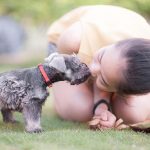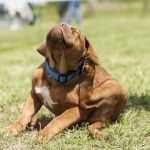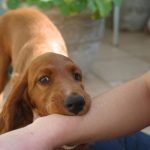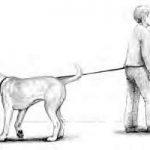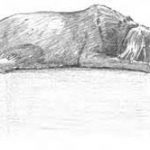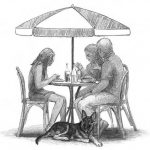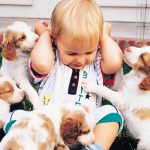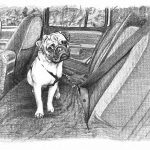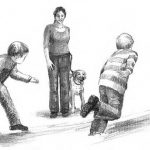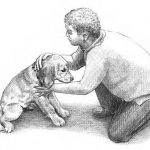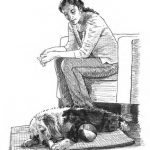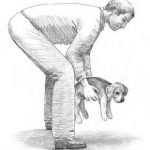Housetraining for Success

In This Chapter
- Using direction instead of correction for housetraining success
- Determining a potty routine for your puppy
- Understanding the differences between paper and outdoor training
- Housetraining your pup kindly and cheerfully
I wish I had a nickel for every time I heard “He knows it’s wrong! Just look at his eyes — guilt’s written all over his face.” Interestingly enough, even though puppies know when you’re mad, they can’t connect your reaction to their own actions, even if they happened only a few short seconds before.
Understand Your Puppy’s Natural Potty Impulses
- Eat
- Drink
- Rest or emerge from isolation
- Play
- Chew
Remember
Your puppy will often let you know that he needs to go out before he eliminates. Like a child, he’s driven to communicate physical discomfort, but rather than crying for attention, he’ll nip excessively and become restless. Correcting the nipping will only result in confusion. Instead, consider a bathroom run when he gets ornery and always remember to direct him with familiar words. Hang a bell on the route to his potty spot and within no time, he’ll be ringing to clue you in to his potty needs (see “Helping your pup communicate his need to go,” later in this chapter, for more).
Warning!
If you find that your puppy has no capacity to hold his urine — he’s even going in his crate or when stationed — he may have developed a urinary tract infection. If you think this is the case, take a sample of your puppy’s urine in and ask your veterinarian to check it. To collect a sample from your pup, take a plastic container outside and catch a spray of morning urine by holding it under your puppy as he goes. Either race over and drop it off at your veterinarian’s within an hour or refrigerate it for preservation.
Direction versus Correction
Tip
Have a small puppy and a large house? If you don’t restrict his freedom, he may develop a habit of running into an unoccupied space to potty instead of interrupting you. Yes, it’s a polite thing for him to do, but it’s obviously not a pleasant thing. To stop him, limit his freedom and be patient until proper habits are more firmly established.
Time
Remember
Commit to the time housetraining takes, and make doing it right a priority. Your attitude can ease your puppy’s misunderstanding, but if you let frustration creep in, your tension will stress him out.
Direction
Make a clicker-happy connectionIf you want to put the hurry on your puppy’s housetraining connection, employ a clicker. The clicker, which is described in detail in Chapter Using Cool Tools and Groovy Gadgets, highlights the moment your puppy cooperates with a sharp click. You follow the click with a yummy snack. For example, discover a dog treat that your puppy will do flips for, and then reward him postclick the moment he eliminates in the right spot. |
Tip
Pick a potty area that’s in a discreet location either close to the house or in a quiet room. Like people, dogs don’t like to potty out in the open, nor should they learn to wander to eliminate. Because eliminating puts puppies in a vulnerable position, privacy is best.
Consistency
Remember
Consistency is the bedrock of creating any habit — including housebreaking! Tell your family and friends the following:
- Where to take your puppy to potty
- When to take him to potty
- What his behavioral signs are (from pacing to quick exits or frantic nipping rituals) before he potties
- Your route to the potty area, including any sound cues, such as a word or ringing a bell
- Your catchphrase that’s said during the potty ritual, such as “Get busy”
Establishing Structure and Routine
– Regulate attention and walks. Number one on the hit parade is to realize the importance of delaying reconnections. For example, you know your puppy lives for his relationship with you. But when your puppy gets up from a nap or is released from isolation (at any time of day), don’t greet, cuddle, walk, or chat with him. Simply direct him with the appropriate command, such as “Outside,” “Elevators” (if you’re in a high-rise), or “Papers.” Reconnect lovingly only after he has pottied. Continue this ritual until he’s fully housetrained.
– Blaze a trail. Always follow the same path to the potty spot. Encourage everyone to follow this route. Go out the same door consistently until your puppy is fully housetrained. See Figure 12-1 for an example. If you have a small dog or young puppy, don’t carry him to his potty area. Let him walk so he can learn how to navigate the path on his own.
– No roaming. When you arrive at the area, ignore your puppy until he eliminates. Don’t walk around letting him sniff or potty around the neighbor’s house. A human parent would never toilet train a child by sending him to the neighbors, so don’t do the same with your puppy.
– Create behavioral memory. As your puppy is eliminating, use a second command such as “Get busy!” After a month of saying this phrase while he’s in the process of pottying, your puppy should be able to go on cue.
– Don’t be stingy with the praise. When your puppy’s done, greet, praise, and walk him as usual.
Getting on a potty-time schedule
Remember
Use the following general guidelines for your puppy:
Table 12-1 Housebreaking Schedule for Work-at-Home Owners | |
Time of Day | Potty Time |
Early morning wake up | Go outside |
Breakfast | Go outside after breakfast* |
Midmorning | Go outside |
Afternoon feeding | Go outside after eating* |
Midafternoon | Go outside |
Dinnertime (4 to 6 p.m.) | Go outside after dinner* |
7:30 p.m. | Remove water |
Midevening | Go outside |
Before bed | Go outside |
Middle of the night | Go outside if necessary |
Table 12-2 Housebreaking Schedule for Owners Who Work Outside the Home | |
Time of Day | Potty Time |
Early morning wake up | Go outside |
Breakfast | Go outside after breakfast |
Lunch break feeding and walk | Go outside |
Midafternoon | Young puppies must go out |
Arrival home | Go outside |
Dinnertime (4 to 6 p.m.) | Go outside after dinner |
7:30 p.m. | Remove water |
Before bed | Go outside |
Middle of the night | Go outside if necessary |
Remember
If you work outside the home, take heed: If you expect your puppy to hold his bladder while you’re gone during the day, you’ll be disappointed. Puppies lack the bladder muscles necessary to accomplish such a feat. If you have to leave your puppy all day, create a space that allows for a good stretch as well as a place to potty. However, remember that your puppy will be confused if you expect him to go outside when you’re home.
Tip
When possible, plan your puppy’s homecoming around your vacation time. This initial bonding a training period is an ideal way to kick off your life together!
Changing the routine
Helping your pup communicate his need to go
Remember
When a need presses, a young puppy often whines, circles, or nips. Nipping is the most common reaction — think of it as a healthy way to reach out for your help. Even though you may want to teach him a more civilized signal down the road, for right now, be mindful that a young puppy’s nips may highlight his need to potty. Direct him with “Outside!” or “Papers!” Whatever you do, don’t correct him.
Tip
To help your puppy learn more appropriate signals, teach him to do the following:
– Ring a bell or chime: Secure a bell or chime at your puppy’s nose level, raising it as he grows (see Figure 12-2). Tap the bell just before you go on a bathroom run. If your puppy has access to the door, hang it there. Otherwise, start by hanging it next to that gate, stairway, or banister that encloses him. Ring the bell for or with him for a week. If he doesn’t catch on, discreetly smear butter or cheese on the prompter before you approach it first thing in the morning. When he goes forward to lick it, open the door immediately and reward him with a treat.
– Bark near his area: If your puppy is a barker, teach him to bark on cue. As you approach the exit area for a potty outing, encourage him to “Speak.” When he does, praise him lavishly, and on you go outside. Good puppy!
Using Papers versus Going Outside
Tip
Paper training is a good option if you have a small puppy, you live in an apartment, you’re physically challenged, or you’re just not the outdoor sort. It has several similarities to outdoor training (see “Establishing Structure and Routine,” earlier in this chapter):
- Consistently use the same bathroom spot (inside or out).
- Use a word or phrase — such as “Papers” — when you lead your puppy to the area.
- After you bring your pup to the area, ignore him until he eliminates.
- As your puppy’s eliminating, use a word or phrase such as “Get busy.”
- Don’t use the place as a play or interaction area.
Remember
Paper training does have one main difference from outdoor training, however: namely, that the papers are within the home. If you’re paper training, keep the papers away from your pup’s food and water bowls and sleeping areas. Place the papers in a discreet location, such as a corner of the kitchen or bathroom, on a nonabsorbent surface (tile, linoleum, or wood), and make sure they’re easily accessible to your puppy, even when you’re not home.
Cross-Training: Going Inside and Outside to Potty
Remember
This cross-training option is slightly more difficult for your pup to comprehend, but any routine can be established as long as you’re consistent. Just be clear on your expectations — that he eliminates on paper when you’re out or during inclement weather and outside all other times — and he’ll eventually learn to follow the routine. Following are some suggestions:
– Establish a routine for going outside when you’re home and in all but extreme weather.
– Get your puppy to ring a bell to alert you when he needs to go and routinely take him to a predestined spot near the door or exit way.
– When you’re not home, secure your puppy in a small room or playpen with papers or pads. Clean these pads in front of your puppy (to reinforce eliminating in the right place) calmly when you return home and return to business as usual. Keep your puppy confined near you if he tries to venture off to potty elsewhere in the house.
– During inclement weather, place the papers down in a distant room in your home, preferably the garage or mudroom, hallway, or by the exit door. As you approach, call out “Papers!” and lay them down.
Tip
If your puppy doesn’t eliminate within 5 minutes, either carry, crate, leash, or otherwise confine for 5 to 15 minutes before trying again. Not only will this prevent an accident, but it will also help your puppy build his bladder muscles and ability to “hold it.” Whining, nipping, and carrying on are all signs he may need a potty break.
Be a good dog owner: Pick it up!Regardless of where you live, picking up after your dog is a good idea. Stools attract bugs and worms. In the city and many suburbs, cleaning up after your dog is the law. Retail scoopers are available at pet stores, or you can do what I do:
Because bags are easy to carry on walks, you should never have an excuse for not cleaning up after your pooch. |
Quick Tips for Housetraining Success
– Start with a small confinement area. Puppies are den animals, and the classic den wasn’t more than about 90 square feet. Most young or untrained dogs won’t soil the area right around them, but if they can race upstairs or into an adjacent room, they’re more than happy to relieve themselves there.
So keep your puppy confined. Crate your puppy at night and when you’re out, or station him as outlined in Chapter Home Sweet Home. After he learns the rules, you can grant him more freedom, but not now. Before letting your puppy run willy-nilly through all the rooms in your home, review Chapter Home Sweet Home for tips on a more gradually integrated approach.
– Clean up accidents privately. Don’t let your puppy see you clean up his mess. Doing so signals a nurturing acceptance that encourages a repeat performance. Isolate your puppy in another room or with a family member as you clean it up.
– Neutralize the odor. Your puppy has a very sensitive sniffer. He’ll automatically return to areas where his smell is concentrated. Use a pet store formula or a 50:50 mixture of water and vinegar to remove the scent.
– Know when corrections count. If you catch your puppy in the process of eliminating in the house, startle him. Clap your hands as you say “Ep, ep, ep!” Jump up and down like an excited chimp or abruptly slap the wall with your palm. Once you’ve interrupted your pup, relax your posture and calmly direct him to the elimination area as if nothing happened. When he’s done, praise him for finishing.
Special confinement issues for pet store pupsPet store pups often have a rough go of the don’t-soil-your-area concept. After all, they had no choice in that early impressionable time away from Mom. If the puppies were from a puppy mill, they more than likely had to go in their kennel space, and they were probably stacked on top of other dogs who were forced to do the same thing. If any mother dog had her way, she’d teach her pups to move far away from their sleeping area to go potty. If your pet-store puppy is having a problem with soiling in his sleeping area, the crate may not be the best option for housetraining because it symbolizes a potty area. At night, a young puppy can sleep at your bedside in a large opentopped box or secured on a leash to your bedside (after he’s leash trained and comfortable with daytime stations). During the day, keep your puppy with you or confine him in a small room, taking him outside or to the papers as often as your schedule will allow (ideally within half-hour to two-hour periods). Take him to the same area, over and over, following the routine described in the housetraining sections (“Establishing Structure and Routine” and “Using Papers versus Going Outside”). Having another dog eliminate in this area is helpful because the scent can give your puppy the right idea. |
– Know when corrections don’t count. As much as you want to think your pup’s human, he isn’t, and your frustration and anger toward your puppy just make you look foolish. Even though I’ve heard the idea a thousand times, I’m still not convinced that a “puppy understands the meaning of a correction.” Sure, you can frighten a puppy into a fearful posture, but scaring him isn’t the point you’re trying to make.
If you catch your pup soiling someplace other than his designated area, you can interrupt the process, but lay off all other corrections.
– Maintain a stable diet. Avoid changing dog food brands unless your veterinarian directs you to do so. Your puppy doesn’t digest food the way you do: His intestine is small and unable to process and absorb a varied diet.
– If your puppy is pooping in the house, lay off food treats. If you give food sporadically throughout the day, his elimination habits will be random.
– Watch the water intake. Puppies, especially young ones, drink water excessively if they’re bored or nervous. If your pup is having housebreaking problems, monitor his water intake by giving him access to his water bowl during meal times and as you take him to his area.
Warning!
Be careful not to dehydrate your pup. If he’s panting or very lethargic, give him a bowl of water. Remove water after 7:30 p.m. If he needs a drink after that time, give him ice cubes to play with or a small amount of water (1⁄4–1⁄2 cup) to quench his thirst.
Sarah Hodgson





